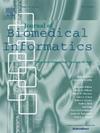DOME: Directional medical embedding vectors from Electronic Health Records
IF 4
2区 医学
Q2 COMPUTER SCIENCE, INTERDISCIPLINARY APPLICATIONS
引用次数: 0
Abstract
Motivation:
The increasing availability of Electronic Health Record (EHR) systems has created enormous potential for translational research. Recent developments in representation learning techniques have led to effective large-scale representations of EHR concepts along with knowledge graphs that empower downstream EHR studies. However, most existing methods require training with patient-level data, limiting their abilities to expand the training with multi-institutional EHR data. On the other hand, scalable approaches that only require summary-level data do not incorporate temporal dependencies between concepts.
Methods:
We introduce a DirectiOnal Medical Embedding (DOME) algorithm to encode temporally directional relationships between medical concepts, using summary-level EHR data. Specifically, DOME first aggregates patient-level EHR data into an asymmetric co-occurrence matrix. Then it computes two Positive Pointwise Mutual Information (PPMI) matrices to correspondingly encode the pairwise prior and posterior dependencies between medical concepts. Following that, a joint matrix factorization is performed on the two PPMI matrices, which results in three vectors for each concept: a semantic embedding and two directional context embeddings. They collectively provide a comprehensive depiction of the temporal relationship between EHR concepts.
Results:
We highlight the advantages and translational potential of DOME through three sets of validation studies. First, DOME consistently improves existing direction-agnostic embedding vectors for disease risk prediction in several diseases, for example achieving a relative gain of 5.5% in the area under the receiver operating characteristic (AUROC) for lung cancer. Second, DOME excels in directional drug-disease relationship inference by successfully differentiating between drug side effects and indications, correspondingly achieving relative AUROC gain over the state-of-the-art methods by 10.8% and 6.6%. Finally, DOME effectively constructs directional knowledge graphs, which distinguish disease risk factors from comorbidities, thereby revealing disease progression trajectories. The source codes are provided at https://github.com/celehs/Directional-EHR-embedding.

DOME:来自电子健康记录的定向医学嵌入向量。
动机:电子健康记录(EHR)系统的日益普及为转化研究创造了巨大的潜力。表示学习技术的最新发展导致了电子病历概念的有效大规模表示以及知识图,从而增强了下游电子病历研究的能力。然而,大多数现有方法都需要使用患者级别的数据进行培训,这限制了它们使用多机构电子病历数据扩展培训的能力。另一方面,只需要摘要级数据的可伸缩方法不包含概念之间的时间依赖关系。方法:采用摘要级EHR数据,引入一种定向医学嵌入(DOME)算法,对医学概念之间的时间方向关系进行编码。具体来说,DOME首先将患者级别的电子病历数据汇总到一个非对称共发生矩阵中。然后计算两个正点互信息矩阵,分别对两两先验/后验依赖进行编码。然后,对两个PPMI矩阵进行联合矩阵分解,得到每个概念的三个向量:一个语义嵌入和两个方向上下文嵌入。它们共同提供了EHR概念之间时间关系的全面描述。结果:通过三组验证研究,我们突出了DOME的优势和转化潜力。首先,DOME将现有的用于几种疾病(如肺癌)的疾病风险预测的方向不可知嵌入载体在接受者操作特征(AUROC)下的区域内持续提高了8.1%。其次,DOME通过成功区分药物副作用和适应症,在定向药物-疾病关系推断方面表现出色,在AUROC中,其性能相应地比最先进的方法提高了6.2%和5.5%。最后,DOME有效地构建了定向知识图,区分疾病危险因素和合并症,从而揭示疾病进展轨迹。源代码提供于https://github.com/celehs/Directional-EHR-embedding。
本文章由计算机程序翻译,如有差异,请以英文原文为准。
求助全文
约1分钟内获得全文
求助全文
来源期刊

Journal of Biomedical Informatics
医学-计算机:跨学科应用
CiteScore
8.90
自引率
6.70%
发文量
243
审稿时长
32 days
期刊介绍:
The Journal of Biomedical Informatics reflects a commitment to high-quality original research papers, reviews, and commentaries in the area of biomedical informatics methodology. Although we publish articles motivated by applications in the biomedical sciences (for example, clinical medicine, health care, population health, and translational bioinformatics), the journal emphasizes reports of new methodologies and techniques that have general applicability and that form the basis for the evolving science of biomedical informatics. Articles on medical devices; evaluations of implemented systems (including clinical trials of information technologies); or papers that provide insight into a biological process, a specific disease, or treatment options would generally be more suitable for publication in other venues. Papers on applications of signal processing and image analysis are often more suitable for biomedical engineering journals or other informatics journals, although we do publish papers that emphasize the information management and knowledge representation/modeling issues that arise in the storage and use of biological signals and images. System descriptions are welcome if they illustrate and substantiate the underlying methodology that is the principal focus of the report and an effort is made to address the generalizability and/or range of application of that methodology. Note also that, given the international nature of JBI, papers that deal with specific languages other than English, or with country-specific health systems or approaches, are acceptable for JBI only if they offer generalizable lessons that are relevant to the broad JBI readership, regardless of their country, language, culture, or health system.
 求助内容:
求助内容: 应助结果提醒方式:
应助结果提醒方式:


